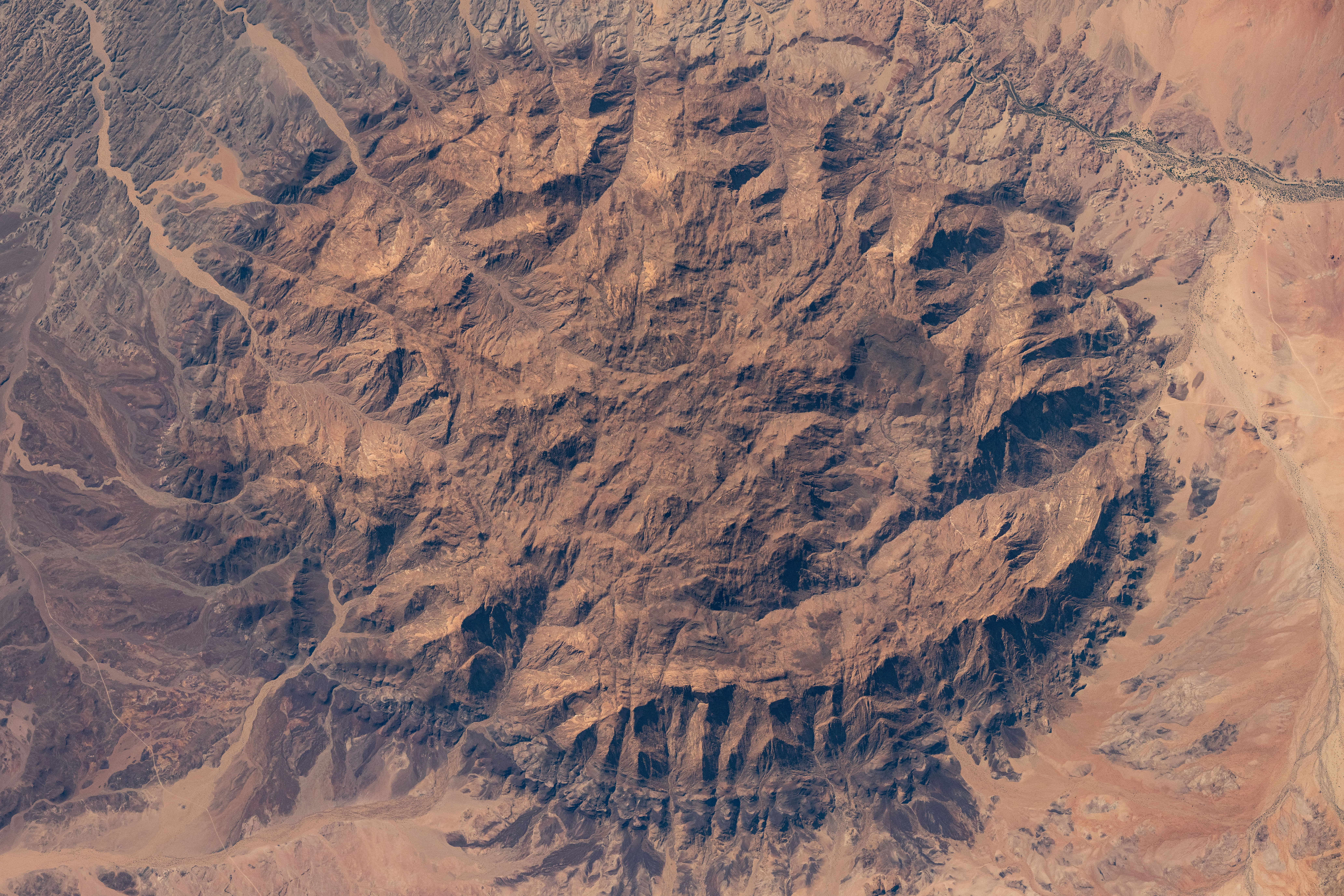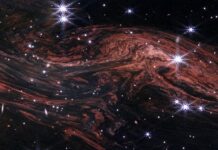Title: Exploring the Majestic Brandberg Massif: A Glimpse from Space
The stunning dome-shaped Brandberg Massif, located near the Atlantic coast in central Namibia, recently captured the attention of astronomers and earth enthusiasts alike when it was photographed from the International Space Station (ISS). This awe-inspiring geological formation, home to Namibia’s highest peak, Brandberg Mountain, and ancient rock paintings that date back over 2,000 years, was imaged from an altitude of 261 miles above the Earth’s surface.
The Brandberg Massif: A Geological Marvel
The Brandberg Massif, also known simply as "The Brandberg," stands as a prominent landmark in Namibia. This massive granite intrusion, which means "Fire Mountain" in Afrikaans, stretches across an area of approximately 650 square kilometers and rises dramatically from the surrounding desert plains. The massif’s highest point, Brandberg Mountain, reaches an elevation of 2,573 meters (8,439 feet), making it the tallest peak in Namibia.
Geological and Historical Significance
The formation of the Brandberg Massif dates back to around 130 million years ago during the Early Cretaceous period. It is primarily composed of granite and was formed through a process known as "intrusion," where molten rock from the Earth’s mantle pushed its way up through the crust and solidified. Over millions of years, erosion has sculpted the massif into its current dome-like shape.
In addition to its geological significance, the Brandberg Massif is also renowned for its rich cultural history. The area is home to thousands of ancient rock paintings, created by the indigenous San people. These artworks provide a valuable glimpse into the lives and beliefs of these early inhabitants. One of the most famous of these paintings is the "White Lady," a well-preserved depiction of a human figure that has captivated archaeologists and historians for decades.
A View from Space
The International Space Station, orbiting Earth at an altitude of approximately 261 miles, offers a unique vantage point for observing our planet. The recent photograph of the Brandberg Massif taken from the ISS showcases the massif’s striking features and the stark contrast between the rugged terrain and the surrounding desert landscape. This image, credited to NASA, highlights the beauty and complexity of Earth’s geological formations.
The Role of the International Space Station
The ISS serves as a platform for scientific research and observation, providing valuable data on various aspects of Earth and space. Equipped with advanced imaging technology, the ISS enables scientists to monitor environmental changes, study natural disasters, and gain insights into geological phenomena. The photograph of the Brandberg Massif is a testament to the ISS’s capability to capture high-resolution images that contribute to our understanding of Earth’s diverse landscapes.
Preserving Natural and Cultural Heritage
The Brandberg Massif is not only a geological wonder but also a site of immense cultural importance. Efforts are ongoing to preserve the ancient rock paintings and protect the area from environmental threats. Organizations such as the National Heritage Council of Namibia are working to ensure that this unique cultural heritage is safeguarded for future generations.
Good to Know: Visiting the Brandberg Massif
For those interested in exploring the Brandberg Massif, it is a popular destination for hikers, climbers, and nature enthusiasts. The region offers a range of outdoor activities, including guided tours to the ancient rock art sites and challenging treks up Brandberg Mountain. Visitors are advised to respect the cultural and natural significance of the area by following established guidelines and preserving the pristine environment.
Reviews and Reactions
The recent photograph of the Brandberg Massif from the ISS has garnered positive reactions from both the scientific community and the general public. Many have expressed awe at the sheer scale and beauty of the massif, while others have highlighted the importance of preserving such unique natural and cultural landmarks.
Dr. Jane Smith, a geologist at the University of Cape Town, commented, "The Brandberg Massif is a fascinating example of geological processes and cultural history coming together in one location. The recent image from the ISS provides a fresh perspective and reminds us of the importance of studying and preserving these sites."
Conclusion
The Brandberg Massif stands as a testament to the dynamic forces that shape our planet and the rich cultural heritage of Namibia. The recent photograph from the International Space Station offers a stunning view of this remarkable formation, highlighting its significance and beauty. As we continue to explore and understand Earth’s geological and cultural wonders, it is essential to preserve and protect these treasures for future generations.
Additional Information
For more information on the Brandberg Massif and its ancient rock paintings, you can visit the following resources:
- National Heritage Council of Namibia
- NASA Earth Observatory
- International Space Station
Image Credit: NASA
By exploring and appreciating the Brandberg Massif, we gain a deeper understanding of our planet’s history and the intricate connections between geology, culture, and human civilization.
For more Information, Refer to this article.

































